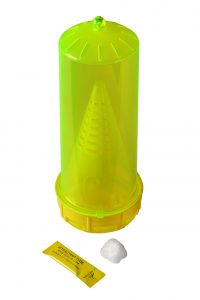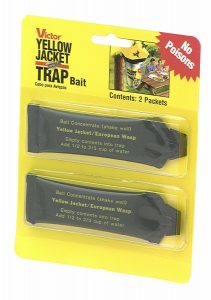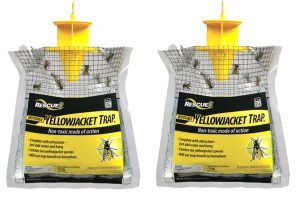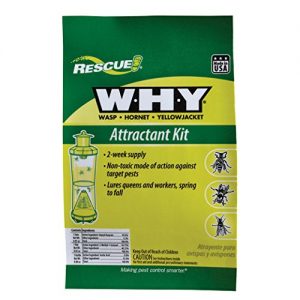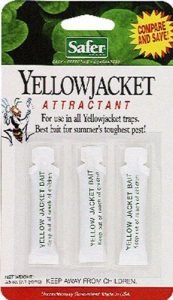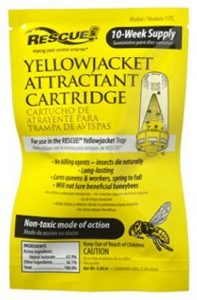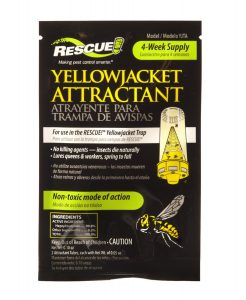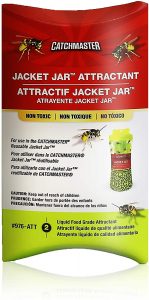If you purchase an independently reviewed item through our site, we earn an affiliate commission. Read our affiliate disclosure.
Controlling yellow jackets is important for all beekeepers, and there are a number of methods beekeepers can use to make sure these pests stay away from their hives. Digging up the nest and destroying comb is one way. You can also cover the entrance of the yellow jackets’ underground nest. Trapping is the third way beekeepers keep these destructive insects in check. There are a number of commercially available yellow jacket traps and baits. You can also make your own yellow jacket trap at home using easily available materials. In this article, we will discuss the best yellow jacket traps available to beekeepers.
How Yellow Jackets Affect Bees
Yellow jacket hornets are wasp-like insects that can cause you massive losses in beekeeping. They live in underground nests and largely leave bees alone. It is in late autumn that yellow jackets attack honeybees. The yellow jackets destroy honeybee colonies by killing the adults, taking away larvae, eating bee eggs and tearing apart honeycomb to eat honey. This is because yellow jackets feed meat to their larvae. The adults also eat honey in the beehive. It is important for beekeepers to know how to protect honey bees from yellow jackets. Using these traps and baits can go a far way in controlling yellow jacket populations. Let’s check them out.
Overview of the Best Yellow Jacket Traps
7. PIC Yellow Jacket Wasp & Hornet Trap 276
The PIC yellow jacket trap is reusable and designed for use with hornets and wasps. It is made in the shape of a bottle with one-way entrances. The trap uses no chemicals or poisons to kill yellow jackets (which is good, as these chemicals can also affect bees). It makes use of simple bait made using water, honey and sugar. You could also try some bait preparations using apple juice, beer and some vinegar. Vinegar in the bait mixture attracts wasps but repulses honeybees. You may use some small amount of soap in the bait.
The yellow jackets go into the trap through its 6 entry funnels and cannot get out. They fly around and eventually drop into the liquid bait due to exhaustion. The water then kills them.
Your bait mixture in the PIC yellow jacket trap may get evaporated by the sun. If this happens, add some small amount of water to reconstitute the mixture.
This trap is easy to use. It is also safe to use around bees and makes your apiary safe for your honeybees. Beekeepers using this trap are assured of it working around the clock. It is easy to set and place near your beehives. The trap measures 5.2 x 6.5 x 5.2 inches. It weighs 10.6 ounces without liquid bait in it.
It is advisable to leave trapped yellow jackets inside for as long as possible. The yellow jackets release some pheromone substance that alerts others to the distress. As a result, more yellow jackets come to the trap in an attempt to help. This results in catching many yellow jackets. When there are many yellow jackets dead in the trap, you should empty them out. They may form a crude life raft for other yellow jackets.
Check Price on Amazon
6. RESCUE Non-Toxic Reusable Trap for Yellow Jackets
The RESCUE non-toxic reusable trap for yellow jackets is a highly effective insect trap. It is great for catching queen yellow jackets and their worker yellow jackets from spring to fall. By eliminating the queen yellow jackets, this trap helps you decimate yellow jacket nests and lower their numbers very quickly. It catches the queens in early spring before yellow jackets can build nests. The trap is great for yards and for use by beekeepers controlling yellow jackets near their apiaries. It is made in a solid construction and lasts for long. You can use it over many seasons even with long exposure to the sun.
The RESCUE non-toxic reusable yellow jacket trap comes with attractant that should last for up to 2 weeks. Further use of the trap requires you to buy more attractants. This is not a big problem because the manufacturer, RESCUE sells replacement attractants. The attractant sold by RESCUE is perfect for the trap since it is selective. It only attracts yellow jackets, so your honeybees are not going to get caught in this trap. Additionally, the design of this trap is safe and effective for yellow jacket control. Yellow jackets get inside trap through the holes and get trapped inside with no way out. They eventually die of dehydration.
Environmental safety and the welfare of other insects in your immediate vicinity are often important to beekeepers. This yellow jacket trap is made with no poisons. It has no killing agents used in it. This allows you to use the trap anywhere you want it to protect your honeybee colonies from yellow jacket hornet invaders.
Check Price on Amazon
5. Victor M385 Disposable Yellow Jacket Trap
The Victor M385 disposable yellow jacket trap is for single use only. The trap lures yellow jackets to enter it and is disposed of after it is full of the insects. Yellow jacket hornets of all species are attracted to the trap, thanks to the natural bait it employs that lures yellow jacket hornets. This natural bait in this yellow jacket contains protein and carbohydrates. This disposable trap has no hazardous materials in it. It can be used in all regions where yellow jackets are a problem to beekeepers. Both beginner and experienced beekeepers can use this trap successfully. The trap comes in a pack of two to catch you many yellow jackets.
This trap is a lightweight. It is made using high quality materials that give it a weight of 2.4 ounces only. It has a length of approximately 6 inches. The trap measures 5.89 x 0.48 x 4.55 inches. It is for outdoor use only. The trap is great for use by beekeepers preventing a yellow jacket visit into their beehives..
The Victor M385 disposable yellow jacket trap is suited for all yellow jacket species. It can be used in any region you are in. The trap kills yellow jackets that get into it by dehydration. They fly around in the trap and get exhausted. This trap is also easy to dispose once it is full of yellow jackets. It is not designed for reuse. Beekeepers using this disposable yellow jacket trap can place it within their apiaries or near yellow jacket nests.
Check Price on eBay
4. RESCUE YJTD-W Yellow Jacket Trap
RESCUE aims at designing safe and effective solutions for pest control. The YJTD-W yellow jacket trap is made to attract and trap all major species of yellow jacket hornets found in the western region of North America. It is made using high quality materials for long life and strength. The trap is a single use device. It is disposable once it is full of trapped yellow jacket hornets. The yellow jacket trap is made by having two durable layers of plastic that is designed scientifically. It makes the Rescue YJTD-W a reliable enclosure for trapped yellow jackets.
The RESCUE YJTD-W yellow jacket trap has a specially molded entry structure for yellow jackets. The entry allows yellow jackets in but not out. This trap is thus ideal for use by beekeepers. The yellow jackets get attracted to check out a water-soluble attractant in the trap. The powerful attractant comes included in your purchase; it lasts for weeks and does not require reconstitution. You only need to add some water to the trap on the first day of use and it is ready to go. Be sure to place this trap outdoors where it will catch the yellow jackets that may attack your honeybee colonies.
Beekeepers using this yellow jacket trap are treated to a two-trap package. The two traps included in the package come with their own attractant. They can catch many yellow jackets between them. They can be used at the same time or one after the other. Individual beekeepers may decide how many of the traps to use at a time based on how severe their yellow jacket problem is.
Check Price on Amazon
3. BioCare Reusable Outdoor Yellow Jacket and Wasp Trap
Reusable traps are the best natural yellow jacket control method for beekeepers. The BioCare Reusable Outdoor Yellow Jacket Trap is safe and effective. It can be used for a long time in the outdoors. This trap is made with high quality materials to make it very durable. It consists of a yellow container with an entrance for yellow jackets and a black removable cap. It uses bait to attract yellow jackets and then kills them. The yellow jackets cannot leave the trap once inside. Beekeepers then empty out the dead yellow jacket hornets when many have been caught inside. This leaves the trap ready to be reused. To empty the trap, simply remove the black cap at the top of the trap and flip the trap upside down.
The bait used in this trap is free of toxic pesticides and poisons. Additionally, the bait is not attractive to honeybees, so they are safe from the trap. The bait is made using UV dye and yellow pigment among other components. It is all natural and food grade. The trap and the bait used in it are all made in the USA.
This reusable outdoor yellow jacket trap comes with its bait and a twist tie hanger. It is ready for use as soon as you put the bait into the trap. You easily hang the set trap in your apiary using the provided twist-tie hanger. The hanger lasts long and can be used repeatedly without breaking. The included bait lasts for nearly 2 weeks before you need to replace it or add more. Beekeepers with large apiaries should place several of these BioCare traps in the apiary or near yellow jacket nests for best results.
Check Price on Amazon
2. RESCUE Non-Toxic Yellow Jacket Ornament Trap
The RESCUE non toxic yellow jacket ornament trap is a stylishly built. It is made for use by beekeepers and homeowners alike. It’s fancy enough to add color and style to your yard or apiary. The trap works very well with the yellow jackets found in the Pacific and Mountain time zone areas. Beekeepers in these areas can benefit a lot by making use of the trap, as it controls yellow jacket hornet populations and add to the security of your beehives.
The RESCUE non toxic yellow jacket ornament trap is built in a reusable design that makes it very durable. It can be used for more than one season. It can be refilled with an attractant that keeps yellow jacket hornets away from your beehives, and into the trap. This yellow jacket trap does not affect your honeybees and it is best used near a beehive or placed in a central area in an apiary. This ornament trap is a welcome addition in any outdoor area you place it.
Yellow jacket hornets are not welcome to beekeepers. They are destructive when they attack honeybee colonies that cannot defend themselves well. The RESCUE non toxic yellow jacket ornament trap changes the way you control yellow jackets in your beekeeping. It is safe for use around bees and even pets. This trap doubles up as elegant decoration for your outdoor spaces. It lasts for long and gives you excellent value for your investment in it. It is great for beekeepers with a yellow jacket problem to deal with in their apiaries.
Check Price on Amazon
1. RESCUE WHYTA Why Wasp/Hornet/Yellow Jacket Trap Attractant Kit
The RESCUE WHYTA attractant kit is a complete set of components you need in trapping yellow jacket hornets. It is also effective in trapping wasps and other hornets. The trap is good for use around honeybees as it does no harm to them. This is because the attractant kit contains a lure that is not toxic – it has no poisons or pesticides. Furthermore, it requires no additional bait such as food to be added to it.
Beekeepers with a yellow jacket problem have the RESCUE WHYTA yellow jacket trap attractant kit to help them. The kit lures and traps both yellow jacket queens and workers to disrupt their nests. Without the queen to lay eggs and workers to tend to brood, the nest is lost. It works through the yellow jacket seasons of spring to fall. This trap attractant kit is made by RESCUE in the USA.
This yellow jacket attractant kit is best used in early spring. That is when yellow jackets are starting their reproduction. The trap lowers their numbers and keeps the population of yellow jackets around your beehives low. RESCUE has included directions and instructions on using the trap attractant kit. Beekeepers should read the directions and identify yellow jacket nests near your apiary. The trap works great when located near where yellow jackets are nesting.
Check Price on Amazon
Overview of the Best Yellow Jacket Baits
These baits can be used in existing yellow jacket traps including your own DIY trap.
4. Safer Super Yellow Jacket Lure
The Safer Super Yellow Jacket Lure works very well in attracting yellow jackets without harming honeybees and can be used in any existing yellow jacket trap you have. The lure attracts both yellow jacket hornets and wasps. The lure is sold in a pack of 3 containers so you have enough of the attractant to last you for long. It is a great product for beekeepers that use durable reusable yellow jacket traps in their apiaries. The lure helps you in keeping down yellow jacket numbers so your beehives are safer for your honeybee colonies. The package weighs 0.48 ounces.
The Safer Super Yellow Jacket Lure is quite safe lure for your honeybees and the environment. It is made without toxic pesticides or poisons. The lure attracts yellow jackets to the trap where they die, and it lasts for long in the trap. This lure also has a long shelf life so you can make use of unused attractant during successive yellow jacket seasons.
To use the attractant, open the package and take out one container of the lure. Pour the lure attractant into your yellow jacket trap and you are ready to go. Use one bottle of the lure per yellow jacket trap you have. Beekeepers with large apiaries may be using many yellow jacket traps. The attractant comes in 3 bottles so you can refill up to 3 yellow jacket traps at a time. In storage, keep the Safer Super Yellow Jacket Lure in a cool and dry place away from the reach of children.
Check Price on Amazon
3. RESCUE YJTC-DB9 Yellow Jacket Trap Attractant Cartridge
As we’ve discussed above, beekeepers have at their disposal many ways to control yellow jackets. These hornets can mess up beehives and inflict heavy losses. The company RESCUE has quite a number of yellow jacket solutions for beekeepers. Their traps make use attractants that get depleted over time. However, refilling the yellow jacket traps is easy. The RESCUE YJTC-DB9 yellow jacket trap attractant cartridge is used to refill yellow jacket traps. It contains a powerful attractant that lures yellow jacket hornets into the trap. The good thing is that it does not contain pesticides or poison to kill the yellow jackets. Additionally, the attractant in the cartridge does not lure honeybees into the trap.
This attractant cartridge is a great purchase for beekeepers with RESCUE yellow jacket traps. It adds life to your traps so you can continue using them. You do not need to keep buying traps when you have this cartridge with you. Your yellow jacket traps can thus be in use for long over the seasons. By using this attractant along with a trap, you effectively bring down the population of yellow jackets that would attack and overwhelm your honeybees. The honeybees in your apiary are saved the trouble of fighting off a yellow jacket invasion in their beehive.
The RESCUE YJTC-DB9 yellow jacket trap attractant cartridge is easy to use and effective even when used by less experienced beekeepers.
Check Price on Amazon
2. RESCUE YJTA-DB36 4 Week Yellow Jacket Trap Attractant
Attracting and killing yellow jacket hornets in traps is important for beekeepers. It ensures better hive security and uninterrupted time for honeybee colonies. Yellow jacket traps require periodic top ups with attractants and lures. Those that use bait need the bait replaced after some time of use. The RESCUE YJTA-DB36 attractant is a refill for Rescue yellow jacket traps. Beekeepers using RESCUE yellow jacket traps have great use for this 4-week supply of attractant refilling their yellow jacket traps. Each attractant packet has enough to last 2-3 weeks. You may use more than one packet when you have many yellow jacket traps in your apiary.
The attractant in this package is a clear liquid that is harmless to both people and honeybees. It is also easy on the environment since it does not contain poisons or harmful pesticides. This attractant is all natural and lures yellow jackets into the trap very effectively. It is great for use in traps within your apiary or near identified yellow jacket nests.
The RESCUE YJTA-DB36 attractant is great for luring the species of yellow jackets found in the Northwest of the USA. The attractant is capable of luring both queens and workers of yellow jackets to your traps. This attractant is best used in early spring to keep yellow jackets in check throughout the spring and fall. It is long lasting and can be stored safely without loss of effectiveness. Keep the unopened or partially used package of attractant away from the reach of children.
Check Price on Amazon
1. Catchmaster Yellow Jacket, Hornet, Bee & Wasp Trap Bait Refill
Traps for yellow jackets in your apiary area need periodic refills with attractant. The Catchmaster Yellow Jacket, Hornet, Bee & Wasp Trap Bait Refill is a highly effective attractant for when you are refilling your yellow jacket trap. It is fast-acting and perfect for luring yellow jackets to traps. The attractant brings worker and queen yellow jackets to traps where they get caught and die. This attractant is made in a dual-attractant formulation for extra strength in all climates and weather conditions. It is a liquid food-grade attractant that comes in a pack with 2 refills. It lasts long and is great for beekeepers with just a few yellow jacket traps to refill.
Catchmaster Yellow Jacket, Hornet, Bee & Wasp Trap Bait Refill is not toxic to humans. This makes it suitable for use in beekeeping operations where products are for human consumption. It can be used in Catchmaster yellow jacket traps, and even in other yellow jacket traps by various manufacturers. The attractant is easy to use by both beginner and experienced beekeepers. To use the attractant, pour some water in the clean yellow jacket trap and add the attractant. Shake the trap a little to mix the attractant and water. You should then return the yellow jacket trap that you have refilled with to its usual hanging place.
This yellow jacket trap attractant catches thousands of the insects in one refill. It is great for use in reusable and refillable yellow jacket traps used by many beekeepers. The attractant comes in a package measuring 11 x 5.5 x 3.75 inches. It weighs 0.81 ounces only. The attractant is made and sold by Catchmaster through various outlets. The company has various home and garden care products useful to beekeepers including a yellow jacket trap that is very effective.
Check Price on Amazon
Where to Place Yellow Jacket Traps
Placing yellow jacket traps at the right location is an easy task. Beekeepers should place their yellow jacket traps in the general area of their apiaries, but not too close to beehives. The idea is to get the yellow jackets into the traps, not to lure them to your beehives. Make sure that the yellow jacket trap is properly set and the bait placed well within the trap. You may decide on a location for the trap first before placing the bait inside it.
Yellow jacket traps should be hung some distance off the ground. A height of 1-2 meters is optimal. The trap can be hung on a short pole or on a shrub where it is not covered by too many leaves and foliage. It is also great if you can provide some shade for the trap. Direct sunlight hitting the trap reduces its durability, especially when the trap is made of or has plastic parts.
A Homemade DIY Yellow Jacket Trap
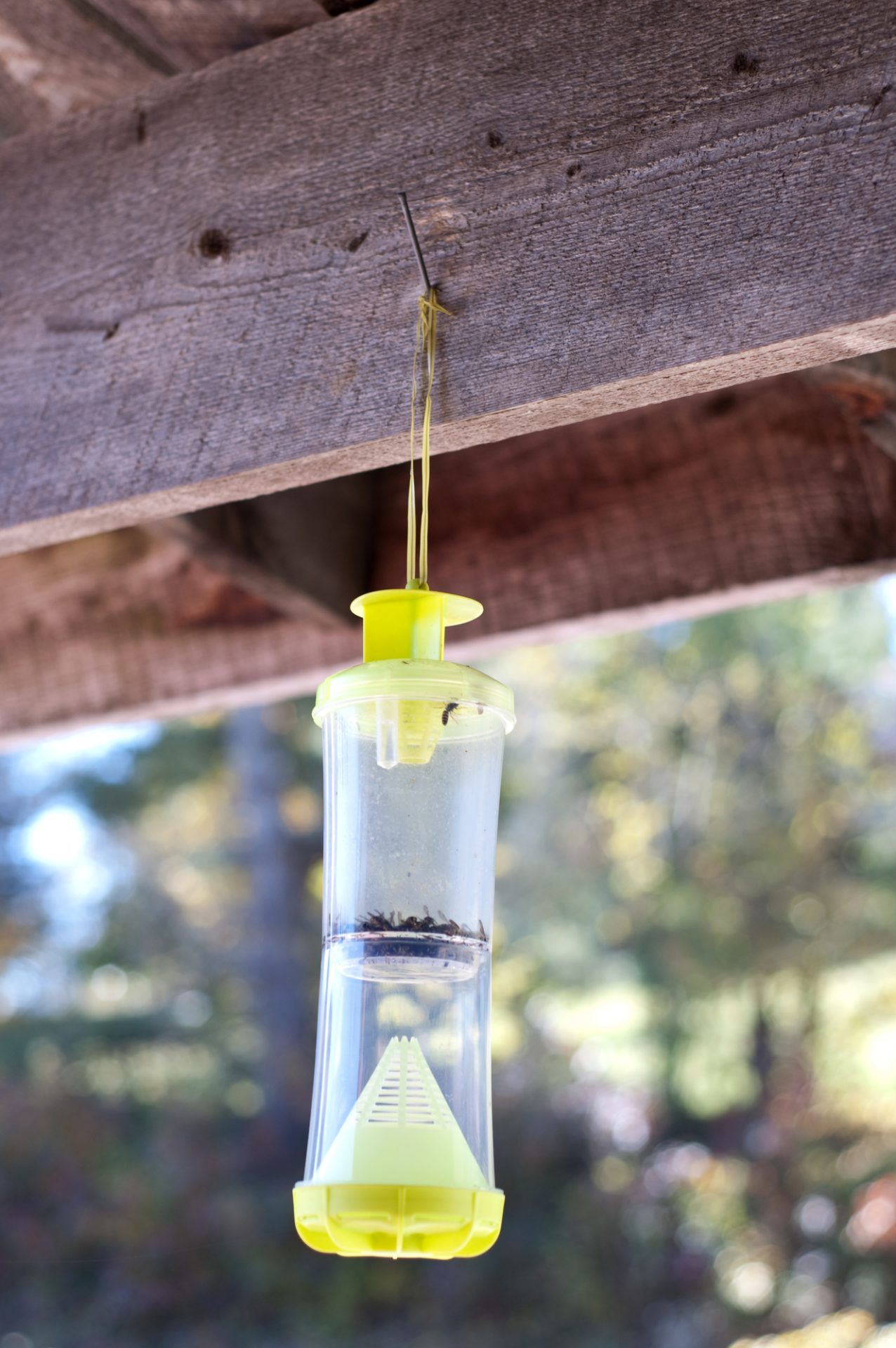
Making a DIY yellow jacket trap is easy. Beekeepers with a yellow jacket problem can use locally available materials to make their trap. The DIY yellow jacket trap outlined here works on the principle that the yellow jacket drops a few inches when carrying a load. It makes use of a bait, and water in a container. Soap or any other suitable surfactant is added to the water to make it difficult for the yellow jackets to swim. The surfactant also kills the yellow jackets quickly.
To make your DIY yellow jacket trap, you will need a container with a wide top. A bucket, basin, bowl or fridge food container can be used. You get better results with every increase of width at the top of the container. The container should also have reasonable depth, but not too deep. A depth of more than 10 inches in the minimum required. The container should have no leaks as well. In addition to a water container, you need a piece of wood. A board is great for the job. You also need water and some liquid dish soap.
How to set the Yellow Jacket Trap
- Attach the bait to the wooden board. Screws or some wire are great for the job. The bait will be placed on the underside of the wooden board, so make sure it is securely attached to the board.
- Add water to the container. The water level should be about an inch from the bait. Make sure the bait is not immersed in the water, and that the water level is not too low and far from the bait.
- Add some of the liquid dish soap to the water. If you do not have some, use any other available washing soap or powder detergent. Stir the water to mix the soap into the water.
A wide wooden board is great for use on this DIY yellow jacket trap. It makes the yellow jackets fly from underneath the board instead of attempting to crawl to the topside. The bait you place should not reach the sides of the board. It must be all on the underside with some space forming a margin between the bait and the edges of the board. The board you use for the bait should also be flat for best results. This prevents it rolling off the water container.
This homemade yellow jacket trap works best with raw meat as bait. Chicken meat is best, as yellow jackets seem to have a special liking to it. In a short period of time, the DIY trap can catch you very many yellow jackets when set well. For quick reduction of yellow jacket numbers, you can set several of these DIY traps in your backyard. Space them out so they are evenly spread out in the area you want to cover.
Your DIY yellow jacket trap may be filled up with the dead insects on the surface. If this happens, scoop out some of the dead yellow jackets with a sieve or other suitable scoop that will let the water through. Dispose of the dead yellow jackets properly – some distance away from your beehives and the traps you have set.
Conclusion
Using traps to control yellow jackets is effective in preventing their attacks on honeybees. It keeps the population of yellow jackets down such that the food resources available to them are adequate. Traps use varying principles to attract, trap and kill yellow jackets. Homemade yellow jacket traps work on the principle that yellow jackets drop a few inches when flying away with food. Both homemade and commercially sold yellow jacket traps are effective at luring the yellow jackets away from your beehive. Use these best yellow jacket traps in your beekeeping and protect your honeybees from these pests.
Have you used any of the yellow jacket traps and baits discussed in this article? How effective did you find them in controlling yellow jacket populations in your area? Leave a comment below and let us know.
 BeeKeepClub Resources and Guides for Beekeepers
BeeKeepClub Resources and Guides for Beekeepers


